You Paid To Live On The Water... Start Planting.
The shoreline of a lake or pond, also known as the littoral zone is a transitional area between the dry land and the open water. This area typically is characterized by the highest light availability, warmest water temperatures and highest nutrient availability, providing ideal conditions for plants and animals to thrive. Establishing beneficial, native plant species in this area can provide many advantages to the local wildlife, the waterbody and the property owner.
Recommendations
Aquatic plants suitable for the littoral zone are lush and robust, providing an enhanced appearance to any pond or lakeshore. To achieve the most visual appeal, choose Pickerelweed, arrowhead and water lily plants which have attractive flowers. Consider planting these species in clusters for the most visual impact
Plants in the littoral zone help prevent and control erosion. Emergent plants (pickerel weed, arrow head, water willow) and shoreline plants (Cardinal flower, bulrush and milkweed), often perform this function the best.
Shoreline plants provide ideal habitat for birds and other animals. Fish receive shade and protection (water lily, water willow), birds and amphibians receive nesting/foraging habitat (water willow, bulrush, cattails, arrow head), and pollinating insects receive a food source (cardinal flower, milkweed, pickerelweed, arrowhead, water lily)
Shoreline plants help maintain the aquatic ecosystem by improving water quality and absorbing excess sediment nutrients and contaminants from the sediments.
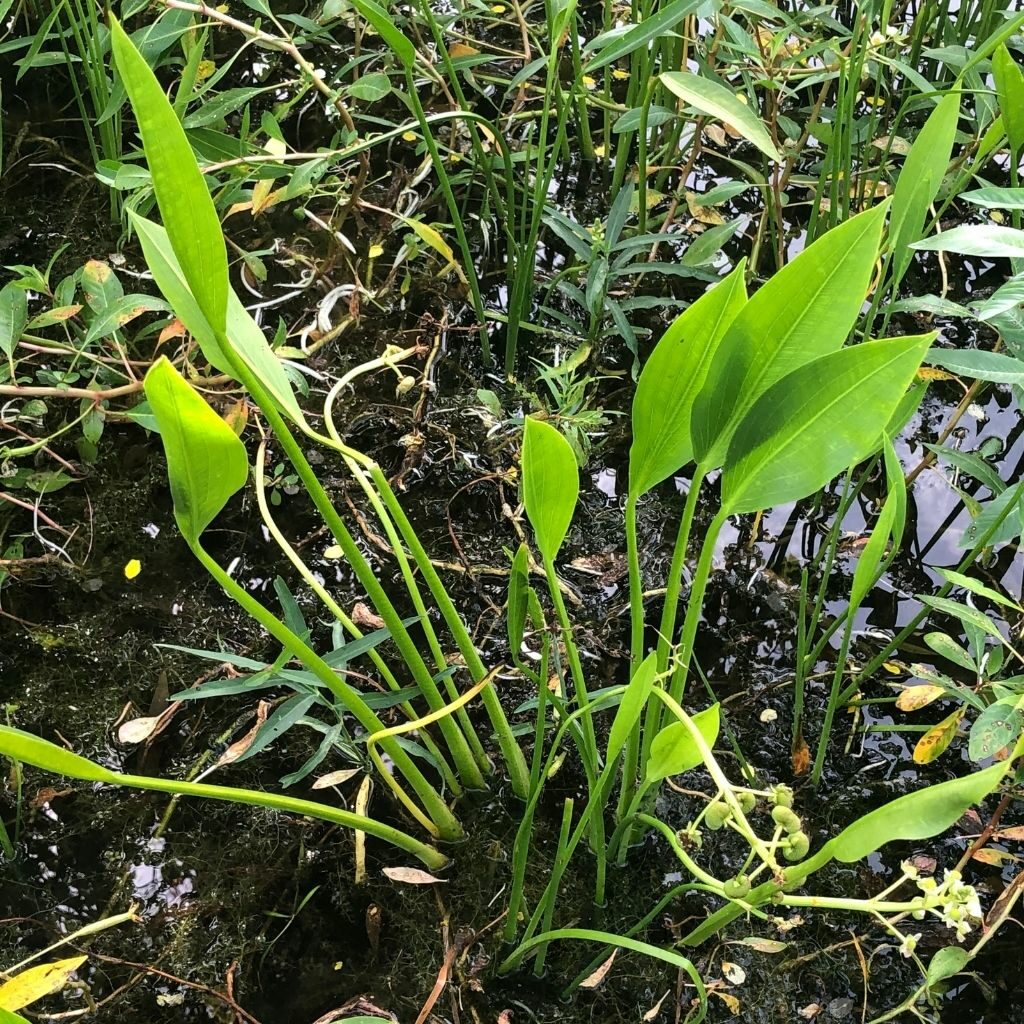
Arrowhead
(Sagittaria spp.)
This broadleaf emergent can be found along the shoreline of lakes and ponds. Growing conditions can range from saturated soil to standing water of up to 4 feet in full to partial sunlight. Several species of arrowhead (pictured is grassy arrowhead) are native to the Midwest, on average they grow between 1 and 4 feet tall, have small white flowers and variable leaf shapes from arrowhead to lance shape.
Pros: Slow spreading, showy flowers, robust, relatively easy to manage, provide food and habitat to many species of wildlife.
Cons: Foliage die off in fall can cause an accumulation of plant material for a short time. Large, old and thick stands of arrowhead can impede shoreline fishing, but for colonies to reach this level would require years of unmanaged growth.
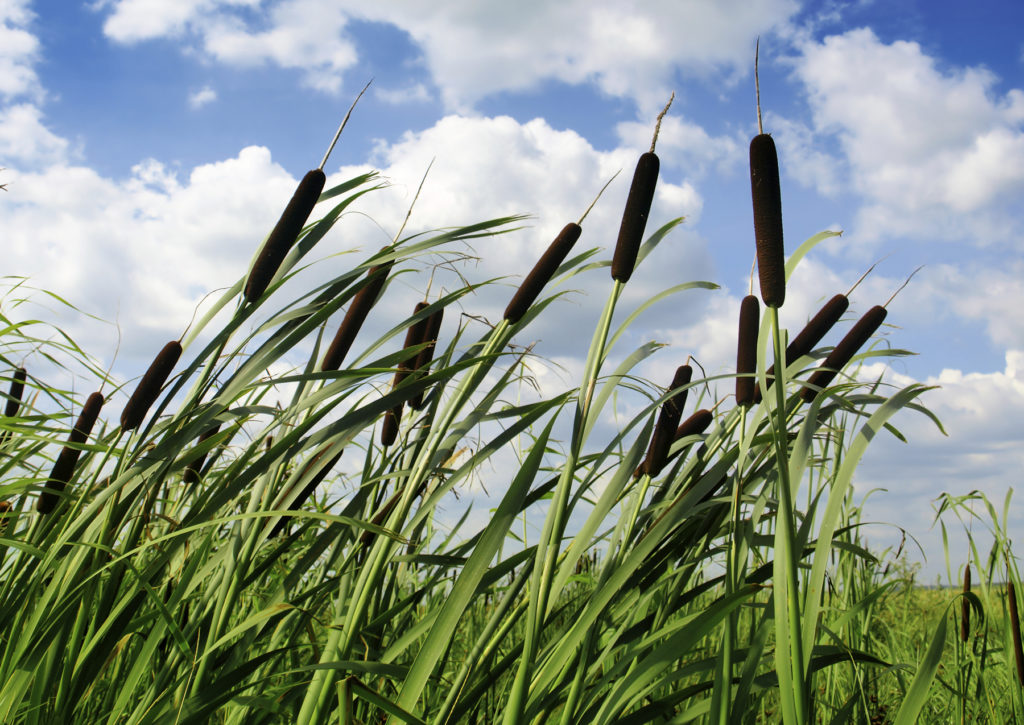
Broad-leaved Cattail
(Typha latfolia)
Probably one of the first species that come to mind when people talk about shoreline plants. Broad-leaved cattail can grow on the bank or in waters up to a 4 feet deep and can grow up to 8 feet tall. They help stabilize the soil to reduce erosion, take up nutrients and contaminants, and provide food and habitat for mammals, waterfowl, birds, amphibians and fish.
Pros: Very robust, fast growing, excellent erosion control and contaminant mitigation. Easy to manage growth. High quality nesting habitat for certain bird species.
Cons: Can quickly become a nuisance, can block view of water and obstruct recreational activities.

Bulrush
(Schoenoplectus spp.)
Bulrush are shoreline to shallow water emergent plants. Growing conditions commonly range from saturated soil to standing water of up to 1 foot deep, but spread to depths of 2 feet is possible. They prefer full sun and can grow to several feet in height. Bulrush provide valuable habitat for shoreline nesting birds, help stabilize sediment, absorb excess nutrients, filter runoff and provide habitat for invertebrates, fish and birds.
Pros: Not as aggressive or obtrusive as cattails. Help stabilize shorelines. Interesting seed heads.
Cons: Can be slow to spread and some species have the potential to grow up to 6 feet tall.
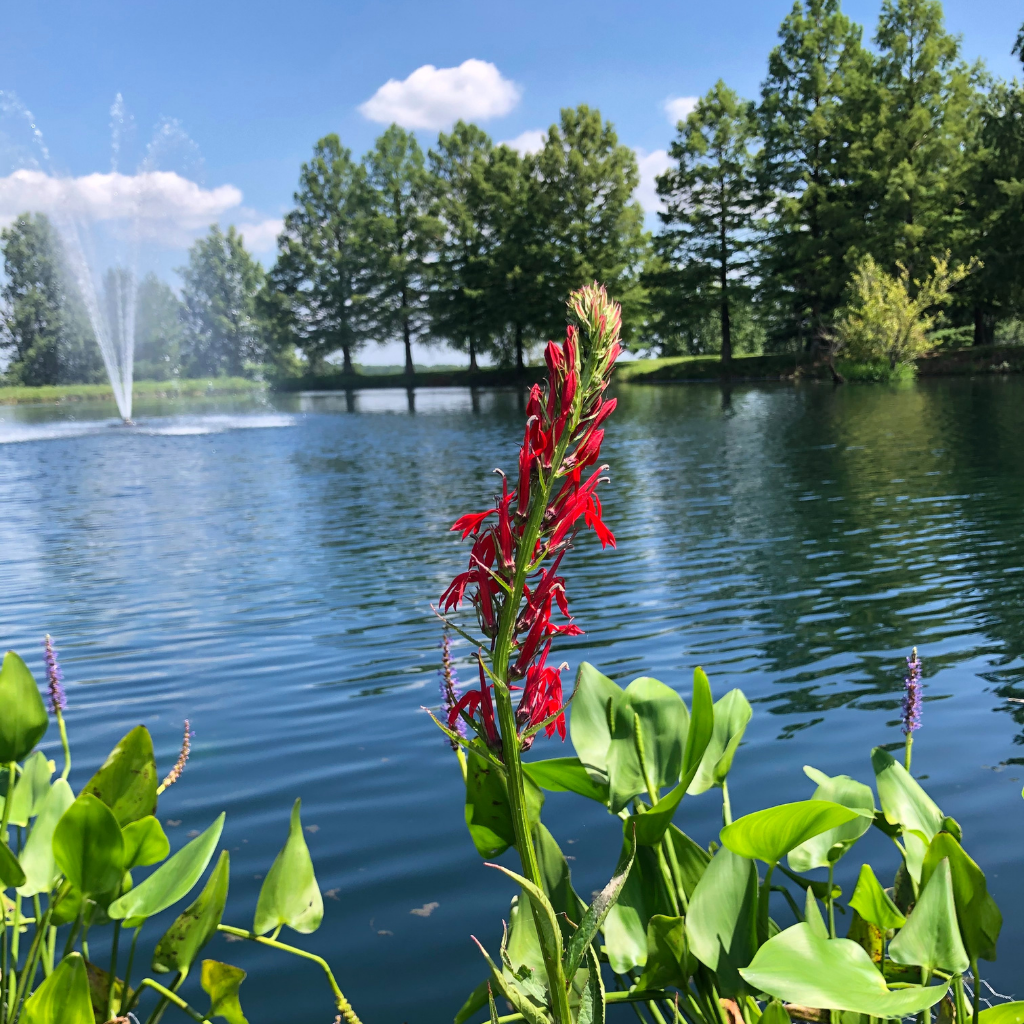
Cardinal Flower
(Lobelia cardinalis)
Cardinal flower is one of the more vibrant native wildflowers indigenous to the Midwest. Each plant has a tall single stalk that can grow as tall as 5 feet. The top spikelet has multiple bright red blooms that attract hummingbirds, butterflies and other pollinators. Cardinal flower tolerates seasonal flooding and can be planted in full shade, partial shade or full sunlight. This plant prefers to be planted higher on the bank in moist soil but can grow in water depths of 4 to 6 inches.
Pros: Very showy and a good way to attract pollinators.
Cons: Short lived, original plants will likely only persist for a few seasons so continual stands of cardinal fowler rely on the germination and recruitment of the previous seasons seed production.
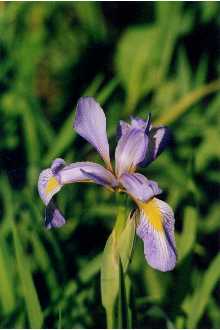
Iris
(Iris spp.)
Iris are an often-sought-after ornamental and while many cultivars exist there are several species of iris native to the Midwest. Growing approximately 3 feet tall and inhabiting wet soils and waters up to 6 inches deep, this plant is a good choice for shorelines and wet places. Iris typically bloom in May or June and have large purple (or blue) flowers. Once established it is recommended that Iris beds be thinned every three to five years by digging out crowded areas. The dug-up Iris can then be transplanted to new areas if desired. Iris spread via both seeds and rhizome.
Pros: Blooms early in the growing season. Robust and transplants easily. Provides a food source for early season pollinators and aquatic mammals.
Cons: Short seasonal bloom time. If colonies are not thinned every 3 to 5 years the over crowding can lead to a reduced number of blooms.

Pickerelweed
(Pontederia cordata):
This emergent shoreline plant grows well in full and partial sun, in saturated soil or water depth of up to 6 inches. Pickerelweed produces large and attractive purple flowers spikes throughout the summer that attract pollinating insects. The plant stabilizes sediments, filters nutrients and runoff, provide shallow water habitat and hunting locations for aquatic and semi-aquatic species. The plants are not likely to grow taller than 3 or 4 feet and should not obstruct the view of the water. They are not likely to grow in water >3 feet.
Pros: Showy, unobtrusive and hardy. Provides habitat for all manner of aquatic and wetland species of wildlife. Easy to control and unlikely to spread quickly.
Cons: Foliage dies off in the fall and can leave plant matter along the shorefront. Thought it does decompose quickly. Large, old and thick stands of pickerelweed can impede shoreline fishing, but for colonies to reach this level would require years of unmanaged growth.

Pondweeds
(Potamogeton spp)
Pondweed species, specifically those with large and broad submersed leaves, make some of the best fish habitat, due to being rooted in the sediment and often extending through the water column to the surface. This species’ complex structure creates habitat for fishes of many different size classes and stages of life as well as provides habitat for aquatic invertebrates and amphibians. Pondweeds can grow very thick if left unchecked and impede swimming, boating and shoreline fishing so it is best to establish pondweeds away from high use recreational areas. Pondweeds are fully aquatic plants that can be found in water as shallow a few inches out to depths of up to 10 feet.
Pros: Excellent fish habitat. Nothing else can compare to the complexity of structure at multiple depths throughout the water column. Help keep water clear.
Cons: Can be difficult to control and keep from spreading. Can be a nuisance to boaters and swimmers.

Spatterdock
(Nuphar spp.)
Similar to water lily, spatterdock is an emergent plant with pad like leaves and a single yellow flower on a separate stem. Unlike water lily, spatterdock leaves are more oblong than circular and tend to stand out of the water instead on floating on the surface. Spatterdock normally will grow in depths of up to 5 feet but can be found in deeper water if sunlight penetration is good enough.
Pros: Provides good habitat for aquatic and semi aquatic wildlife. Excellent cover for ducklings. Helps lessen sedimentation of lakes and ponds. Removes contaminants from sediment. Can be easily maintained into sections of beneficial habitat.
Cons: Can become quite thick if left unmanaged , leading to loss of swimming and boating areas.

Swamp Milkweeds
(Asclepias incarnata)
One of the few milkweed species that can thrive in wet soil, this plant prefers saturated soil but can grow in water that is up to 4 inches deep. Requires full to partial sun exposure and individual plants can grow up to 5 feet tall. Blooming throughout the summer it provides a continuous visual attraction for both people and wildlife.
Pros: Crucial habitat for the endangered monarch butterfly and is a readily available food source for many types of pollinators throughout the summer.
Cons: Milkweed has a tendency to become top heavy and fall over, uprooting itself if not planted together with other plants to help anchor the roots and support the stems. Dead stalks persist through the winter months and may need to be cut down.
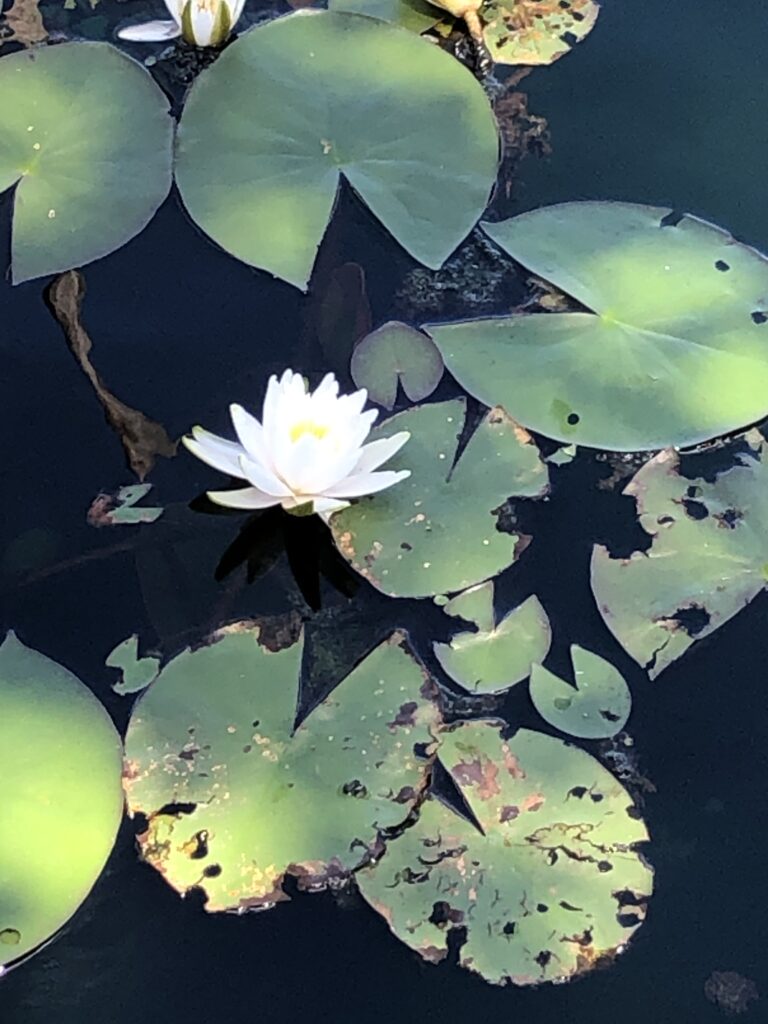
White Water Lily
(Nymphaea odorata)
Lilies are one of the most popular shoreline species due to their attractive blooms, iconic floating leaves and value as fish cover. They absorb sediment available nutrients and pump oxygen to the sediment around the roots to further oxidize and reduce nutrients. Lilies produce pads that cover the water at the end of long stems. The pads can shade the water, providing cooler habitat for fish in the summer months. Blooms attract numerous pollinators and pads provide resting areas for amphibians. Lilies may grow or extend out to water that is up to 9 feet deep if there is sufficient light penetration at that depth to support new growth. Due to their ability to expand to deeper water, they should be planted away from swimming and high recreation use areas. Instead, install these plants in areas where aesthetics or natural fishing habitat are desired.
Pros: High aesthetic value, creates good ambush habitat for largemouth bass. Helps keep shallow waters cooler during the summer. Easily visible for fishermen to target.
Cons: Can take over shallow water if given enough time and left unmanaged.
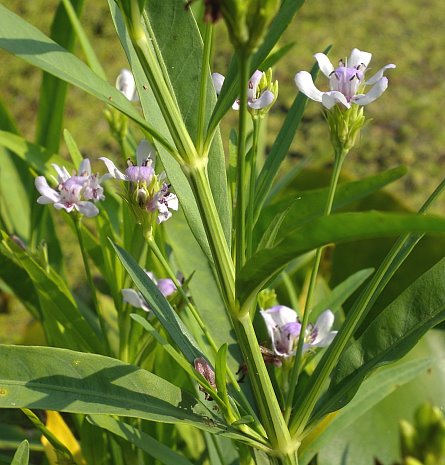
Water Willow
(Justica americana)
Usually found growing in full to partial sunlight and in saturated soils out to depths of 1 foot, water willow provides numerous ecological benefits. This shallow water plant stabilizes shorelines and sediment, absorbs nutrients, filters runoff, attracts pollinating insects, and provides exceptional habitat for small forage fishes, fry and young of year age classes as well as invertebrates. Largemouth bass will target this species for hunting habitat. At an average height of 2 feet this plant will not block the view of the water front.
Pros: Creates good habitat for all types of aquatic and semi-aquatic species. Helps protect shorelines from wave action and reduces erosion.
Cons: Can form very thick colonies over time, making it a hazard to cast into. Can takeover shallow areas (<2 feet deep) if left unmanaged.

